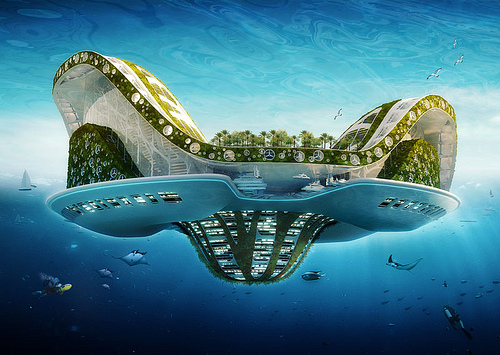Lilypad, a floating eco-city for climate refugees conceived
2010-01-14 from:BREAKING NEWS author:trevor
Vincent Callebaut, a French-Belgian architect, has conceived and published what can only be described as a really cool floating eco-city for "climate refugees," reports said yesterday.
The concept is based on the premise that the planet is warming up because of contamination and glaciers' melting will cause sea levels to rise around the world. Small countries like Trinidad and Tobago and other Caribbean islands can even disappear if sea levels rise high enough, according to the global warming theory.
According to estimates by the United Nations' Intergovernmental Panel on Climate Change, sea levels could rise by as much as 20-90 centimeters this century. Scientists say an increase in global temperatures by only one degree can send the sea level up by one meter.
This would put many densely populated parts of the world under water. Parts of the Netherlands, Bangladesh, India and islands in the Pacific would almost disappear if scientists' gloomiest predictions are correct. That's if the sea level raises by one meter. If it ascends by two meters, the rise could drown millions of homes in South East Asia, Egypt and the Caribbean.
While some are wiped off the planet, others such as New York, Bombay, Calcutta, Shanghai, Miami, Lagos, Jakarta and Alexandria could become new "Venices" the experts say.
Scientists say the consequences would be economically devastating and create at least 250 million "climate refugees" who would be unable to return to their homes and need relocation.
To house these millions of refugees, a young French-Belgian architect, Vincent Callebaut, has conceived the Lilypad, a floating, self-sufficient, clean-energy city. The eco-city serves a double purpose and that is to expand the territories of coast-endowed countries such as those in the Persian Gulf and Holland, which already employ man-made islands to this end. With Trinidad and Tobago also considering building the Caribbean's first man-made island off the coast of Otaheite Bay, the Lilypad option or something similar could be considered.
The Lilypad is also reportedly mobile, meaning the island can float with the currents and wind.
Callebaut's islands are envisaged to each house at least 50,000 inhabitants and would be built around a central submerged lake that would collect rain water for freshwater needs of the population. The "mountains" that surround the lake would hold the homes, offices and malls.
Lilypad would have three ports and each one would be covered by gardens and hanging grottoes that would be used for food and other fresh produce cultivation. The objective would be that the inhabitants could live indefinitely on their self-sufficient and optionally nomadic island.
The structure of the floating city was inspired by a giant water lily found in the Amazon forest, multiplied on a scale of 1:250.
As a totally self-sufficient entity, Lilypad would also be compliant with environmental goals of balancing climate, biodiversity and water.

The project would also produce more energy than it consumes, using a number of renewable sources including solar, thermal, photo-voltaic, wind, hydro, tidal, and osmotic energy to name a few. Everything would be recyclable and the island would produce as much oxygen and electricity as it needs. The CO2 emissions and waste would be recycled too, as the floating city would feature a number of aquaculture fields to produce food for the more than 50,000 inhabitants. The structure would be built using polyester fibers covered with a type of titanium dioxide, that promises to minimize atmospheric contamination.

